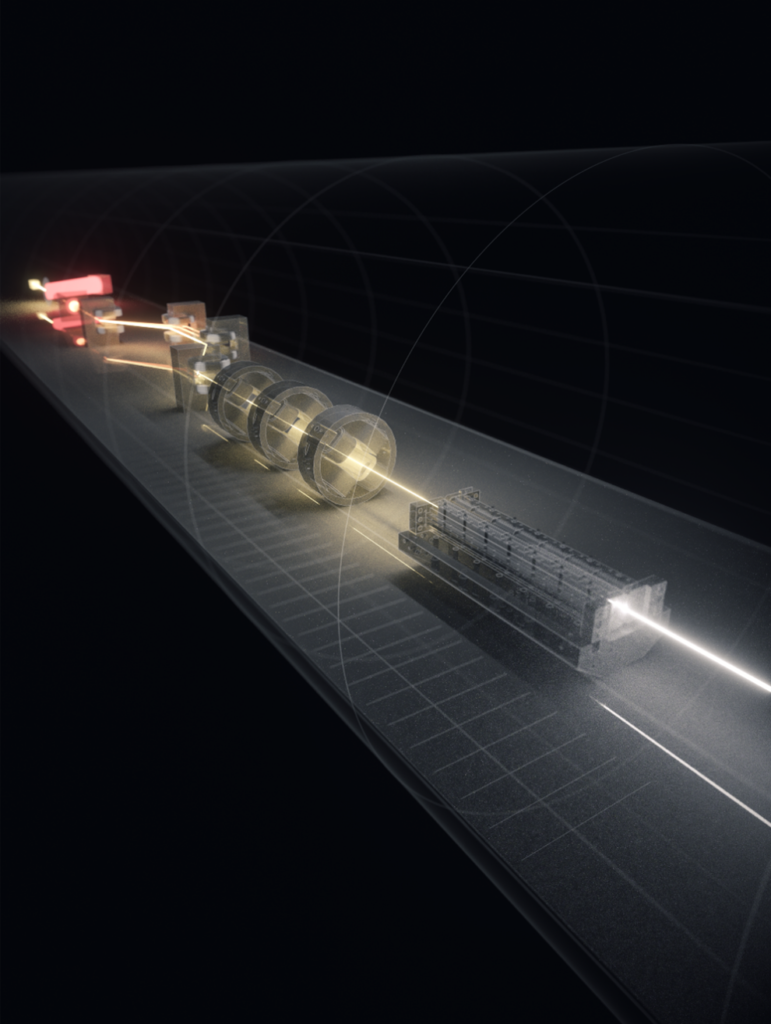Scientists worldwide search for novel approaches to miniaturize X-ray free-electron lasers (XFELs) which could make them cheaper, more accessible, and possibly enable novel capabilities and modalities. XFELs are utilized to create extreme matter conditions for hot-dense matter research, to study properties of materials for next-generation microchips, to resolve the structure of complex biomolecules for new medications, and many other applications highlighted in the UK XFEL Science Case. These prospects ignited a race towards ultra-compact XFELs. Led by University of Strathclyde Prof. Bernhard Hidding and Dr. Brian McNeil, a team of scientists from Strathclyde, UKRI’s Accelerator Science and Technology Centre ASTeC in the UK and Stanford’s SLAC and University of California, Los Angeles, in the US, now has achieved a breakthrough in the STFC-funded “PWFA-FEL: Exploratory Study of PWFA-FEL at CLARA” project.
The results, published in Nature Communications, show with high-fidelity start-to-end simulations, that a Plasma Wakefield Accelerator (PWFA) equipped with an advanced electron injection method called plasma photocathode (aka “Trojan Horse”) can produce electron beams 100,000 times brighter than state-of-the-art. This is because of the low momentum spread distribution: the produced electron beams are very cold. Then, the tens to hundreds of gigavolt-per-meters accelerating electric field in PWFA allows one to realize the accelerator on cm-scale compared to km-scales of traditional accelerators. The study continues with how to extract, transport, isolate and inject the ultra-high brightness, ice-cold electron beams from plasma photocathode PWFA into an undulator without charge and quality loss: they remain cold and do not “melt”. Finally, focused into an undulator, the ultrahigh quality electron beam produces powerful coherent, laser-like photon pulses at the Angstrom wavelength on the fly, with pulse durations in the attosecond regime. In addition to extreme quality of the electron and resulting photon pulses, the entire system may have a spatial footprint of only few tens of meters. The scientists believe that the three milestones achieved in the study could be a gateway to next-generation ultra-compact XFELs.
The first author of the study Fahim Habib a research associate at the University of Strathclyde, and leading post-doctoral researcher of the study, says: “The prospects of ultra-compact plasma-XFELs based on this scheme are mind-boggling. Our results are important first milestones, but much more work is ahead of us towards experimental realization of the approach.” Prof. Bernhard Hidding, who leads the project and in parallel also pushes towards experimental realization in a grant by the European Research Council (ERC) called “NeXource: Next-generation Plasma-based Electron Beam Sources for High-brightness Photon Science” adds: “First experimental evidence for plasma photocathode injection in PWFA has been obtained in our “E-210: Trojan Horse” collaboration at our strategic partner Stanford’s SLAC FACET facility. Now, with our “E-310: Trojan Horse-II” programme at the successor facility SLAC FACET-II, which now comes online, we aim at exploiting the true potential of the scheme in terms of beam quality and stability.”

Dr Peter Williams comments: “Plasma wakefield acceleration has been an active research area for many years, but poor control of beam energy spread has hitherto precluded widespread adoption into user facilities. The Trojan Horse plasma photocathode technique studied in this paper meets this challenge head on, showing cold beams are indeed achievable. This gives us confidence to include PWFA as one of the acceleration techniques in the next generation UK-XFEL proposal. The enhanced brightness and energy reach enabled by PWFA will extend the utility of this major scientific infrastructure to entire fields of research that would otherwise not be served.”
The scientist says such a plasma photocathode PWFA brightness and energy booster stage can be implemented into already existing or future XFEL facilities. This would extend the capabilities and modalities of these machines and open novel scientific avenues. At the Cockcroft Institute PWFA R&D is conducted at the Compact Linear Accelerator for Research and Applications (CLARA). CLARA is an advanced electron accelerator test facility and enables testing concepts presented in this study. PWFA-based brightness and energy booster stages are considered in the UK XFEL (https://xfel.ac.uk/) Science Case from inception. This is a progressive approach and the first of its kind where novel accelerator technology is included from the start in the design of a large infrastructure project. The UK XFEL Conceptual Design Report (CDR) phase will evaluate different options to enable UK researchers’ access to next-generation X-FEL capability. The CDR will investigate the option of a PWFA-FEL station which could give the UK XFEL a competitive advantage and secure the lead in next-generation accelerator technologies.
Background (can be added):
X-ray free-electron lasers (X-FELs) convert the kinetic energy of an electron beam into powerful photon pulses down to hard X-ray wavelengths and they are often called ‘engines of discovery’. X-FELs are utilized to create extreme matter conditions for hot-dense matter research, to study properties of materials for next-generation microchips, to resolve the structure of complex biomolecules for new medications, and many other applications. At the heart of any FEL is a relativistic electron beam swinging on a sinusoidal path inside a so-called undulator with an alternating magnetic field. As a result of the wiggling motion, the electron beam emits bursts of photons. A positive feedback effect structures the electron beam into micro-bunches at the radiation wavelength. Consequently, the radiation power grows exponentially along the undulator and becomes highly coherent. This self-organizing effect can only occur if the electron beam is of high quality at relativistic energies. However, to meet the stringent electron beam quality requirements state-of-the-art X-FELs are km-scale finely tuned machines. This puts X-FELs at a billion-pound price tag. That is why only a handful of X-FEL facilities exist worldwide. No X-FEL exists in the UK so far. To meet the increasing desire by the UK photon science community, a large infrastructure project, the UK X-FEL, is now underway https://xfel.ac.uk/
Reference:
A.F. Habib et al. Attosecond-Angstrom free-electron-laser towards the cold beam limit. Nat Commun 14, 1054 (2023)
